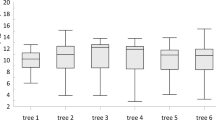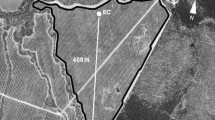Abstract
Actual evapotranspiration (ETc) of three mature sweet orange orchards (cv. Salustiana and Washington Navel on sour orange), under border irrigation and typical cultural practices was measured by the water balance method during 1981 to 1984. Soil water content was measured at 7 to 10 day intervals using a neutron meter and soil sampling of the 0–10 cm surface layer. Zero flux plane was calculated by measurements with mercury tensiometers. Irrigation water in these and other 5 similar orchards was measured by broad crested weirs. Rainfall and other climatic data for calculation of reference evapotranspiration by FAO's methods (ETo) were collected in a nearby meteorological station. Average yearly ETc ranged from 750 to 660 mm and mean monthly maximum was 3.7 and 3.2 mm/day in July for Salustiana and W. Navel orchards, respectively.
ETo estimates for the different methods used were highly correlated (r 2⩾0.94). Monthly crop coefficients (Kc) based on pan evaporation ranged from 0.5–0.6 in spring and summer to 0.8 in autumn and were about 10% higher than those for Penman or radiation methods. Average annual Kc for the three plots studied was 0.64, 0.61 and 0.51, respectively, and correlated well (r 2=0.99) with tree ground cover. Irrigation efficiency was about 50% for orchards with soils with less water holding capacity and more applied water per irrigation and 70–80% in orchards with deeper soils or with a higher water holding capacity. Increasing irrigation frequency and applying smaller amounts of water per irrigation with good uniformity can improve on-farm irrigation efficiency.
Similar content being viewed by others
References
Batchelor C.H. 1984. The accuracy of evapotranspiration estimated with the FAO modified Penman equation. Irrig. Sci. 5: 223–233.
Bautista I., Cruz-Romero G., Castel J.R. & Ramos C. 1985. Spatial and time variability of soil moisture in citrus orchards as measured by neutron probe. Acta Horticulturae 171: 61–73.
Booher L.J. 1974. Surface irrigation. FAO, Agric. Development Paper No. 95.
Bos M.G. & Nugteren J. 1978. On irrigation efficiencies. I.L.R.I., Wageningen.
Camacho-B. S.E. 1977. Some aspects of the stomatal behavior of citrus. Proc. Int. Soc. Citriculture 1: 66–69.
Clemmens A.J. & Reploge J.A. 1980. Constructing simple measuring flumes for irrigation canals. USDA Farmers Bull. No. 2268.
Daudet F.A. & Vachaud, G. 1977. La mesure neutronique du stock d'eau du sol et ses variations. Application à la détermination du bilan hydrique. Ann. Agron. 28: 503–519.
Davis S., Bingham F.T., Shade E.R. & Grass L.B. 1969. Water relations and salt balance of a 1000-acre citrus watershed. Proc. 1st. Int. Citrus Symp. 3: 1771–1777.
Doorenbos J. & Pruitt W.O. 1977. Crop water requirements. FAO Irrig. Drain. Paper No. 24.
Frevert D.K., Hill R.W. & Braaten B.C. 1983. Estimation of FAO evapotranspiration coefficients, J. Irr. Drain. Eng. 109: 265–270.
Greacen E.L., Correll R.L., Cunningham R.B., Johns G.G. & Nichols K.D. 1981. Calibration. In: Greacen E.L. (Ed) Soil Water Assessment by the Neutron Method. CSIRO, Australia.
Green G.C., Burger W.P. & Conradie J. 1974. Lysimetric determination of citrus tree evaporation. Agrochemophysica 6: 35–42.
Green G.C. & Moreshet S. 1979. An analysis of seasonal water use characteristics of Valencia orange trees in the Sundays River Valley. Crop. Prod. 8: 179–183.
Hashemi R. & Gerber J.F. 1967. Estimating evapotranspiration from citrus orchards with weather data. Proc. Am. Soc. Hort. Sci. 91: 173–179.
Hoffman G.J., Oster J.D. & Alves W.J. 1982. Evapotranspiration of mature orange trees under drip irrigation in an arid climate. Trans. ASAE 25: 992–996.
Kalma J.D. & Stanhill G. 1969. Transpiration, evaporation and deep drainage losses from an orange plantation. Israel J. Agric. Res. 19: 11–24.
Khairi M.M.A. & Hall A.E. 1976. Temperature and humidity effects on net photosynthesis and transpiration of citrus. Physiol. Plant. 36: 29–34.
Martin Aranda J. & Muriel Fernandez J.L. 1973. Consumo de agua en una plantación de naranjo amargo (Citrus aurantium L.) plenamente desarrollada. Proc. I Congreso Mundial de Citricultura. Murcia. 1: 277–282.
McGowan M. & Williams J.B. 1980. The water balance of an agricultural catchment. I. Estimation of evaporation from soil water records. J. Soil Sci. 31: 217–230.
Newman J.E. 1968. Estimating water needs of citrus orchards. Citrus Industry 19–24.
Ramos C., Castel J.R. & Gomez de Barreda D. 1986. Some aspects on the use of the neutron probe in irrigation and evapotranspiration studies. Acta Horticulturae (in press).
Replogle J.A. & Bos M.G. 1982. Flow measurement flumes: applications to irrigation water management. Advances in Irrigation 1: 147–217.
Rogers J.S., Allen L.H. Jr., & Calvert D.V. 1983. Evapotranspiration from a humid-region developing citrus grove with grass cover. Trans. ASAE 26: 1778–1783, 1792.
Shalhevet J., Mantell A., Bielorai H. & Shimsi D. 1976. Irrigation of field and orchard crops under semi-arid conditions. Int. Irrig. Info. Center. Publ. No. 1.
Sharma J.L. 1985. Estimating evapotranspiration. Advances in Irrigation 3: 213–281.
Van Bavel C.H.M., Stirk G.B. & Brust K.J. 1968a. Hydraulic properties of a clay-loam soil and the field measurement of water uptake by roots. I. Interpretation of water content and pressure profiles. Soil Sci. Soc. Am. Proc. 32: 310–317.
Van Bavel C.H.M., Brust K.J. & Stirk G.B. 1968b. Hydraulic properties of a clay-loam soil and the field measurement of water uptake by roots. II. The water balance of the root zone. Soil Sci. Soc. Am. Proc. 32: 317–321.
Van Bavel C.H.M., Newman J.E. & Hilgeman R.H. 1967. Climate and estimated water use by an orange orchard. Agric. Meteorol. 4: 27–37.
Weiss A. 1983. A quantitative approach to the Pruitt and Doorenbos version of the Penman equation. Irrig. Sci. 4: 267–275.
Wiegand C.L. & Swanson W.A. 1982. Citrus responses to irrigation. I. Irrigation requirements: daily, monthly and annual evapotranspiration amounts and water management recomendations. J. Rio Grande. Valley Hort. Soc. 35: 73–85.
Author information
Authors and Affiliations
Rights and permissions
About this article
Cite this article
Castel, J.R., Bautista, I., Ramos, C. et al. Evapotranspiration and irrigation effeciency of mature orange orchards in Valencia (Spain). Irrig Drainage Syst 1, 205–217 (1987). https://doi.org/10.1007/BF01102930
Received:
Revised:
Accepted:
Issue Date:
DOI: https://doi.org/10.1007/BF01102930




